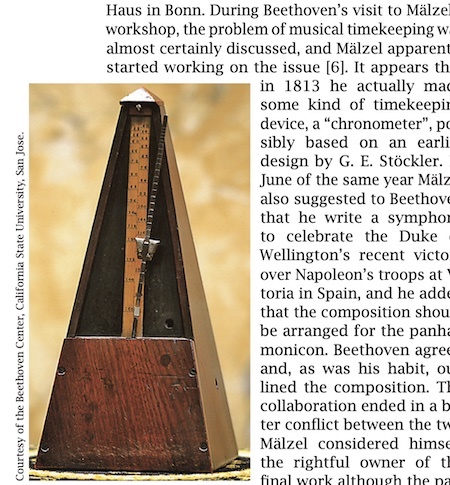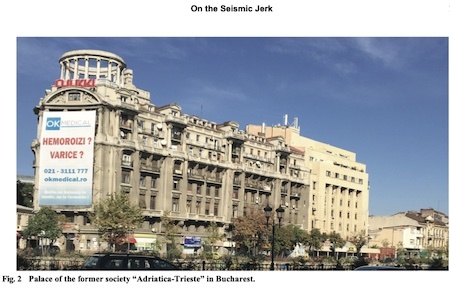Marc Abrahams's Blog, page 75
July 28, 2021
A listen back to the Ig Nobel Prize for Karaoke
BBC News produced this short documentary about the birth of karaoke. It centers on Daisuke Inoue, the person most often credited with inventing karaoke. (Many other people claim credit, too, and it’s entirely possible that several of them did indeed each independently invent the basics, as happens with many technical innovations!)
The 2004 Ig Nobel Peace Prize was awarded to Daisuke Inoue “for inventing karaoke, thereby providing an entirely new way for people to learn to tolerate each other”.
The BBC report features a recording of the moment, at the 2004 Ig Nobel Prize ceremony in Harvard University’s Sanders Theatre, when Daisuke Inoue was awarded the prize, and was serenaded by Nobel laureates Dudley Herschbach, William Lipscomb, and Rich Roberts, and by the audience of 1100 giddy spectators. That magical moment begins at the 6:25 point in the BBC recording.

Ig Nobel Prize-winning Gadgeteer Ron Popeil has finished inventing
Gadgeteer Ron Popeil, who was awarded the 1993 Ig Nobel Prize for consumer engineering, has died, according to press reports. The famed inventor was cited, in winning that Ig Nobel prize, for “redefining the industrial revolution with such devices as the Veg-O-Matic, the Pocket Fisherman, Mr. Microphone, and the Inside-the-Shell Egg Scrambler.”
Here is a report, by TMZ, about his passing:
Behold video recordings of a few of the many television commercials in which Ron Popeil and his minions promoted his inventions, many of which were marketed under the name “Ronco”:

July 27, 2021
“Further Persecution of a Corpse: Beethoven and His Metronome”
Further findings related to the confusion, reported here a few days ago, and elsewhere years ago, about Beethoven and his markings and his metronome:
“Conductors’ Tempo Choices Shed Light over Beethoven’s Metronome,” Almudena Martin-Castro and Iñaki Ucar, PLoS ONE, vol. 15, no. 12, 2020, e0243616. (Thanks to Xavier Purroy Solans for bringing this to our attention.) The authors, at Universidad Nacional de Educación a Distancia and at Universidad Carlos III de Madrid, Getafe, Spain, explain:

During most part of Western classical music history, tempo, the speed of music, was not specified, for it was considered obvious from musical context. Only in 1815, Maelzel patented the metronome. Beethoven immediately embraced it, so much as to add tempo marks to his already published eight symphonies. However, these marks are still under dispute, as many musicians consider them too quick to be played and even unmusical, whereas others claim them as Beethoven’s supposedly written will. In this work, we develop a methodology to extract and analyze the performed tempi from 36 complete symphonic recordings by different conductors. Our results show that conductor tempo choices reveal a systematic deviation from Beethoven’s marks, which highlights the salience of “correct tempo” as a perceptive phenomenon shaped by cultural context. The hasty nature of these marks could be explained by the metronome’s ambiguous scale reading point, which Beethoven probably misinterpreted.

July 26, 2021
The Frog Test [Humour Study]
As some have pointed out, analyzing humour can be a bit like dissecting a frog – the frog always dies.
Nevertheless, Professor Ori Amir, who is not only Visiting Assistant Professor of Psychological Science at Pomona College, US, but also a stand-up comedian – has suggestions for a new humour analysis method, which, he says, might help in alleviating the death of the frog :
The method relies on the assumption that presenting participants with theoretical accounts for a specific joke would shift their attention to those joke elements or the perspective the theory deems relevant. A unique advantage of the method is that it does not require a manipulation of joke content (as does the experimental approach) or determining whether vague or abstract theoretical conditions are met (as does content analysis).
See The Frog Test: A Tool for Measuring Humor Theories’ Validity and Humor Preferences Frontiers in Human Neuroscience February 2016
BONUS : Professor Amir tells neuroscience jokes

July 25, 2021
Podcast Episode #1077: “Danger Assessment of Holy Water”
In Podcast Episode #1077, Marc Abrahams shows an unfamiliar research study to biomedical researcher Chris Cotsapas. Dramatic readings and reactions ensue.
Remember, our Patreon donors, on most levels, get access to each podcast episode before it is made public.
Chris Cotsapas encounters:
“Holy Water—A Risk Factor for Hospital-Acquired Infection,” J.C. Rees and K.D. Allen, Journal of Hospital Infection, vol. 32, no. 1, January 1996, pp. 51–5.
Seth Gliksman, Production Assistant
Available on Spotify, Apple Podcasts, Overcast, Google Podcasts, AntennaPod, BeyondPod and elsewhere!

July 23, 2021
The Wombot and the Wombats
Ig Nobel Prize winner Scott Carver, at the University of Tasmania, and colleagues demonstrate and explain the wombot—their wombat-sized robot for wombat research—in action, in this ABC News report:
The 2019 Ig Nobel Prize for physics was awarded to Patricia Yang, Alexander Lee, Miles Chan, Alynn Martin, Ashley Edwards, Scott Carver, and David Hu, for studying how, and why, wombats make cube-shaped poo.
That prize-winning research is documented in these studies:
“How Do Wombats Make Cubed Poo?” Patricia J. Yang, Miles Chan, Scott Carver, and David L. Hu, paper presented at the 71st Annual Meeting of the APS Division of Fluid Dynamics, Abstract: E19.0000, November 18–20, 2018“Intestines of Non-Uniform Stiffness Mold the Corners of Wombat Feces,” Patricia J. Yang, Alexander B. Lee, Miles Chan, Michael Kowalski, Kelly Qiu, Christopher Waid, Gabriel Cervantes Benjamin Magondu, Morgan Biagioni, Larry Vogelnest, Alynn Martin, Ashley Edwards, Scott Carver, and David L. Hu, Soft Matter, vol. 3, 2021
July 22, 2021
Was Something Wrong with Beethoven’s Metronome?
Was something wrong with Beethoven’s metronome? Well, was something wrong? Well? A fair number of people have tried hard to find out. Four of them produced this mathematics-based analysis:
“Was Something Wrong with Beethoven’s Metronome?” Sture Forsén, Harry B. Gray, L.K. Olof Lindgren, and Shirley B. Gray, Notices of the AMS, vol. 60, no. 9, 2013. The authors explain:

The pianist and musicologist Peter Stadlen (1910–1996), who devoted many years to studies of Beethoven’s markings, regarded sixty-six out of a total of 135 important markings as absurdly fast and thus possibly wrong. Indeed, many if not most of Beethoven’s markings have been ignored by latter day conductors and recording artists….
We investigate possible sources of error as to why Beethoven may not have been able to correctly note reliable and transferable time measures. We hope to demonstrate that there are possible mathematical explanations for the “curious” tempo markings—explanations that hitherto have not been considered except perhaps by Stadlen, who even went so far as to locate Beethoven’s own metronome.
Here is video of one of Beethoven’s composition being played, possibly with incorrect timing, by someone other than Beethoven:

July 20, 2021
Question: What Are “Mainly Triggered by Soap Handling and Random Jerks”?
What Are “mainly triggered by soap handling and random jerks“? That is the question.
A clean answer may, perhaps, appear in the study: “A Robust Device for Large-Scale Monitoring of Bar Soap Usage in Free-Living Conditions,” Rüdiger Zillmer, Richard Wright, Susan Bates, and Ian Mahers, Personal and Ubiquitous Computing, vol. 18, no. 8, 2014, pp. 2057-2064. The authors explain:
“False activations are mainly triggered by soap handling and random jerks…”


July 19, 2021
Painfully fashionable : The consequences of wearing pointy shoes in medieval England [study]
 It’s known that if you wear overly pointy shoes for long periods, you’re likely to damage your feet How long has this been going on? Was it prevalent in, say, medieval Cambridge, UK?
It’s known that if you wear overly pointy shoes for long periods, you’re likely to damage your feet How long has this been going on? Was it prevalent in, say, medieval Cambridge, UK?
To find out, researchers examined the human remains of 177 adult individuals (11th > 15th century) from four cemeteries located in Cambridge, England, to check their toes for shoe damage.
18% had Hallux valgus (deformed big-toes) caused, very probably, by wearing overly pointy shoes (see dwg). The researchers also noted that many of the individuals who had apparently been wearing painfully fashionable shoes also had fractures consistent with falling over – especially so-called FOOSH injuries (Falls On OutStretched Hand ).
Ref : Fancy shoes and painful feet: Hallux valgus and fracture risk in medieval Cambridge, England
BONUS :
This B&W photo, courtesy Kamstein @ Wikipedia, shoes a pair of modern-day(ish) Winkle Pickers.

July 15, 2021
Question: What Is Defined as ‘a Succession of Random Jerks’?
Random jerks fascinate some people, a few of whom, at least, might be captivated by the study “On the Seismic Jerk,” Ramiro Sofronie, Journal of Geological Resource and Engineering, vol. 4, 2017, pp. 147-52. The author reports:

“In the year 1936, only with four years before the strong earthquake that occurred in Romania, on November 10, 1940, the late Professor Aurel A. Beleș (1891-1976), published a paper about the role of jerk in dynamics. Then in 1941, after the earthquake, in his quality of official expert for analyzing the collapse of Carlton Hotel in Bucharest, the same professor published two extended papers together in a book entitled The Earthquake and the Buildings. In that original scientific document an earthquake is defined as a succession of random jerks…”

Marc Abrahams's Blog
- Marc Abrahams's profile
- 14 followers





